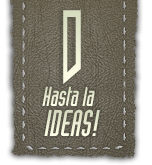Paper Toys: Tougui
Posted in: Uncategorized
French illustrator and paper toy designer Tougui, aka Guillaume Pain, is one of several proponents of a growing paper toy scene whose work is featured in the December issue of CR, out this week.
For the last few years, an underground paper toy scene has been developing across the world largely thanks to the internet and social media. Character designers have been devising templates of their toy creations which can be downloaded, by and large, for free by whoever is interested.
Compared to the costs of making a vinyl toy, realising character designs in paper is a much more affordable option for designers and illustrators to bring their designs to life. And with the vinyl toy market showing signs of tailing off, there’s a big opportunity for paper toys to come to the fore and enter the mainstream.
Especially for our December issue, and to sit alongside our feature on paper toys, Tougui very kindly created a custom toy for us to print a blank template so readers can cut, fold, glue and make their own paper toy. Here are some of Tougui’s most recent paper toy creations, plus a short Q&A with the artist. We’ll share some more paper toy creations by different artists with you throughout this week.

Creative Review: How long have you been creating paper toys?
Tougui: It has been 5 years now.

CR: What do you like about working with paper?
T: What I like about paper is the freedom that it offers in terms of creation and use, I can create whatever shape I want. The only limit is the format my printer can handle and my imagination. It really is very inexpensive medium, so it’s very accessible, and you don’t need any special tools to work with it. All you need is a good pair of scissors and a stick of glue!

CR: Is this something that you will always do – or do you think it’s a fad or a phase you’re going through that will lead to another way of working?
T: I don’t think it’s a fad or a phase. I’ve always been attracted to three-dimensional objects, and geometry in space. When I was a child, I was fascinated by all the construction games, building shacks, and all that kind of thing. When I got a little bit older, I liked modelmaking – I just love building things with my hands. At first, when I discovered the papertoy, I didn’t really ask myself any questions, it was just a game. But since then things have changed! Today, I try and evolve the medium, and I see how I can mix materials, and by experimenting in this way I try and transpose the papertoy for it to be something more than just a toy made out of paper and exposed on a shelf.

CR: Do you think that, in some ways, the economic climate is helping the popularity of paper toys?
T: From an ecological perspective, it is on trend right now I suppose. Economically, I didn’t really ask myself the question before… It’s true that sharing and exchanging papertoys is (in most cases) free of charge, and this plays a critical part in its popularity. What we can be sure of is that the papertoy is a trend, and people in our society like what’s new and fashionable.
But there is a community growing more and more each day around the papertoy, and I think it is really starting to play a serious part in our visual environment. But for now, I can’t say if it will last or not…
The great thing is that the atmosphere among the community is good, and people are receptive to this medium, let’s hope it will keep going this way.

To see more of Tougui’s work, visit his website at tougui.fr

Stay tuned for more paper toy art on the blog this week – and look out for the new December issue of CR in the shops which will feature a bound-in 170gsm blank custom Tougui toy template (in association with Arojowiggins Creative Papers) so you can make your own (blank version shown above). The best customised toy will win prizes! Full details to follow later in the week.







































































